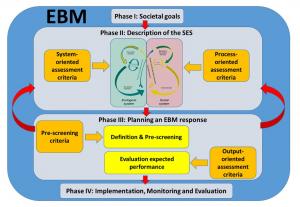The Ecosystem-based management (EBM) approach aims to achieve societal goals while at the same time aiming to restore, enhance and protect the resilience of an ecosystem to sustain or improve the flow of ecosystem services and conserve biodiversity. However, the development of EBM plans for aquatic ecosystems is challenging due to a complexity of the EU policy context and a lack of knowledge transfer between science and stakeholders.
The aim of the report, Making ecosystem-based management operational, is to present the AQUACROSS EBM approach, which will be put into practice in the eight AQUACROSS case studies. The AQUACROSS EBM approach is separated into four distinct phases (see figure), which cover:
- Societal goals: Identification of societal goals based on policy objectives and stakeholder preferences. This policy characterisation includes 1) the identification of key threats to biodiversity, such as human activities and the pressures they cause, 2) an overview of key policy instruments, including their objectives, targets, current deficits or gaps, 3) and key synergies, conflicts and gaps of identified policies and how they tackle or reinforce identified threats.
- Description of the socio-ecological system (SES): Assessment of the baseline scenario, by explicitly distinguishing between the ecological system and the social system. This phase covers the understanding of the functioning of the ecological system, its biodiversity and the ecosystem services it provides. Secondly, the social system and its interaction with the ecological systems are reviewed, such as drivers and pressures.
- Planning an EBM response: This planning phase starts with the pre-screening of alternatives and ends up in the agreement on an EBM plan that aims to preserve or restore resilience and sustainability of the SES. The plan consists of two parts: a Programme of Measures (PoM) and Policy Instruments, integrated into an Implementation Plan (IP).
- Implementation, monitoring and evaluation: which together form the evaluation process of the AQUACROSS EBM plans (PoM and IP). It includes the identification of indicators and their targets, the development of forecasting and scenarios and the evaluation of the management plans.
To make EBM operational, scientific input is crucial to provide accurate knowledge on the status of aquatic ecosystems. Moreover, the AQUACROSS EBM plan particularly aims to integrate stakeholders, to reduce potential conflicts that could eventually represent a risk to cooperation and collective actions, and ultimately threaten the achievement of objectives. An improved dialogue between science, stakeholders and policy makers will support the successful implementation of the EBM plan.
The operationalisation of the EBM approach in the eight case studies will be followed by an assessment of the impact of management responses in the case studies.
The Full Report and Executive Summary are available online.


